Jonathan Franzen has translated and annotated Karl Kraus in a new book:The Kraus Project: Essays by Karl Kraus (2013). It may be Franzen can help us glimpse something useful in this topic.
Let's look at an example. The feuilleton was an 19th century invention. It is a special section of a periodical designed for light entertainment. Kraus saw this development in printing as symptom and perhaps cause of a decline in cultural standards. It is possible the contemporary difficulties in understanding Kraus show the accuracy of Kraus's critique.
Here is Kraus on the topic: “Writing feuilletons means twining curls on a bald head; but these curls please the public better than a lion’s mane of thoughts. Esprit and charm, which presumably were necessary in developing the trick and becoming adept at it, are now passed on by it automatically. With an easy hand, Heine pushed open the door to this dreadful development.”
Let's look at an example. The feuilleton was an 19th century invention. It is a special section of a periodical designed for light entertainment. Kraus saw this development in printing as symptom and perhaps cause of a decline in cultural standards. It is possible the contemporary difficulties in understanding Kraus show the accuracy of Kraus's critique.
Here is Kraus on the topic: “Writing feuilletons means twining curls on a bald head; but these curls please the public better than a lion’s mane of thoughts. Esprit and charm, which presumably were necessary in developing the trick and becoming adept at it, are now passed on by it automatically. With an easy hand, Heine pushed open the door to this dreadful development.”
It sounds to me like Kraus is pointing to the facile linguistic outpouring of modern writings. It means a disinclination to discuss philosophical issues while maintaining a certain sincere and open minded intent to discover accurately. And behind this is the fact of modern education with little training in languages or critical thought. These things were commonplace in the 19th century. Now though more people are educated, the quality of education of fallen sharply, as should be apparent if we consider the paucity of training in foreign languages. Another recent example would be the fact that the vocabulary section of the Scholastic Aptitude Test will soon be deliberately made simpler as the words chosen now will be picked on the basis of whether the words will be useful to the student.
Now, if Karl Kraus viewed the feuilleton as the actual cause of this kind of decline in western literacy, I have to wonder if he is not being himself, too superficial. But I do not know to what he broadly ascribed the developments represented by the feuilleton.
Another writer says of Kraus that he would have found the language of George Bush agreeable fodder for satire. My view is that what Kraus would find suitable for satire is more complex, in our imaginary game of what would Kraus think now. We live in a world in which the smartest people (astrophysicists) can say without being embarrassed, well you can't ask what came before the big bang, because time hadn't been created then.
Clive James is the writer I mention in the last paragraph, and it is in his essay that we read Kraus said: you cannot be satirical about madness.












